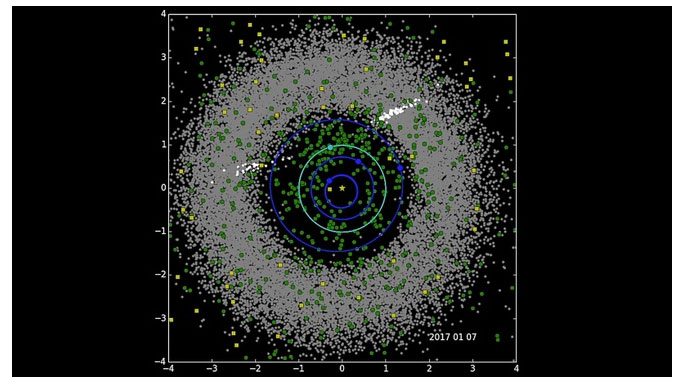In 1,000 years, no asteroid larger than one kilometer is expected to collide with Earth, but smaller meteoroids may still pose a risk.
“There will be no major collisions in the next 1,000 years, which is good news,” said Oscar Fuentes-Muñoz, an astronomer at the University of Colorado (USA), who led the study analyzing asteroids that may come close to Earth, published in The Astronomical Journal.

No large meteors expected to collide with Earth for at least the next 1,000 years. (Photo: Science Photo Library/ Alamy).
Approximately 66 million years ago, dinosaurs were wiped out by a 10-kilometer-wide asteroid. This impact not only eradicated most life on land within hours but also left a layer of dust that blocked sunlight, causing a prolonged winter lasting decades.
Fortunately, such major collisions are rare. NASA previously estimated that asteroids larger than one kilometer, which could cause extinction events like the one 66 million years ago, collide with Earth about once every few million years. However, no one knows if the current period falls within that few million years.
Fuentes-Muñoz’s team believes the answer is no. NASA’s catalog of near-Earth asteroids larger than one kilometer has identified about 95% of existing celestial bodies, which amounts to nearly 1,000 asteroids. Generally, scientists can track the orbits of these asteroids to predict their paths for the next 100 years.

The green dots represent near-Earth objects, the yellow squares represent comets, and the gray dots represent all other asteroids. (Photo: NASA/JPL-CALTECH/PSI).
The new study employed a different method, focusing only on the segments of orbits that approach Earth, rather than the entire orbit. By considering only a small part of the orbit, computational power was conserved to estimate over a longer timeframe, up to 1,000 years, explained Davide Farnocchia, an astronomer at NASA’s Near-Earth Object Program.
The asteroid with the highest chance of colliding with Earth is 1994 PC1, which is about one kilometer wide and has a 0.00151% chance of crossing the Moon’s orbit in the next 1,000 years. Although this percentage is extremely low, it is ten times greater than any other asteroid. “However, this asteroid is not likely to collide,” Fuentes-Muñoz stated.
Nonetheless, smaller asteroids, which are more numerous, still pose risks to Earth. For example, in 2013, a 20-meter-wide meteoroid exploded over the sky of Chelyabinsk in Russia, injuring over 1,000 people. Smaller objects can still cause significant damage.
Fuentes-Muñoz noted that asteroids larger than 140 meters could destroy a city. NASA’s catalog of such asteroids is only about 40% complete. The collision rate depends on the number of asteroids, and since this number is still uncertain, further sky surveys are needed, the expert remarked.
However, for now, humanity can rest easy. “There will be asteroids heading toward Earth, but it is nearly impossible for this to happen before the year 3000,” O’Brien stated.


















































